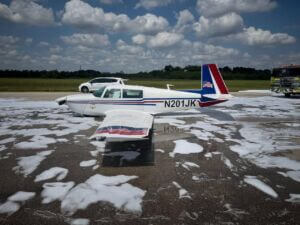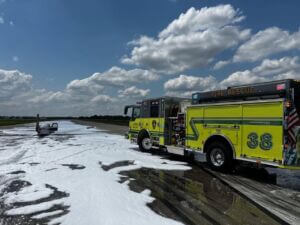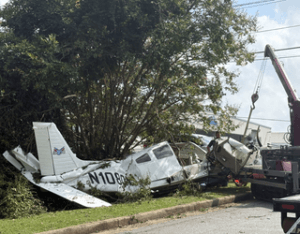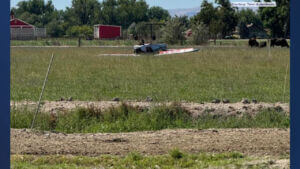We start the new week with these stories...
Be safe out there!
Tom
Aircraft Emergency - Hooks Airport
Klein Fire Department responded to an aircraft emergency at David Wayne Hooks Memorial Airport, mid-morning on Saturday, August 9. At approximately 11:00 am, a pilot reported that their landing gear would not come down.
aircraft emergency at David Wayne Hooks Memorial Airport, mid-morning on Saturday, August 9. At approximately 11:00 am, a pilot reported that their landing gear would not come down.
Responding crews used KFD Foam 30 to apply a foam blanket meant to help prevent fire from any sparking that might occur from landing.
The aircraft circled for a period to help burn off fuel. By approximately 11:54 a.m., the pilot and crew were safely on the ground, without incident.
Responding units: Klein Fire - D30, T30, E31, Foam 30, E38, B38; Spring Fire - D71, E72; Champions Fire - T12; Northwest Volunteer Fire - T41.
30, E38, B38; Spring Fire - D71, E72; Champions Fire - T12; Northwest Volunteer Fire - T41.
Our Community. Our Commitment. We Are Harris County ESD 16, Klein Fire Department.
: Chief C Harvin/ KFD
https://www.facebook.com/share/p/1FYMtCm4Y7/
Small plane crashes in Brookhaven neighborhood, 3 injured
By FOX 5 Atlanta Digital Team
The Brief
-
- A small plane belonging to a flight school crashed into a Brookhaven homeowner’s yard early Saturday morning.
-
- Three people aboard the aircraft were taken to a trauma center; all were conscious, alert, and breathing when transported.
-
- The crash occurred near Clairmont Road and 9th Street, close to the Peachtree-DeKalb Airport.
BROOKHAVEN, Ga. - Three people were hospitalized early Saturday after a small plane crashed into the yard of a Brookhaven home during a training flight.
hospitalized early Saturday after a small plane crashed into the yard of a Brookhaven home during a training flight.
What we know:
The crash happened around 12:25 a.m. at a residence near the intersection of Clairmont Road and 9th Street, not far from the Peachtree-DeKalb Airport, according to Brookhaven police. Chamblee police and the DeKalb County Fire Department also responded to the scene.
All three occupants of the plane were taken to Grady Memorial Hospital. While their current conditions have not been released, police said they were conscious, alert and breathing when they were transported.
The backstory:
Officials said the plane, registered to All2Fly Flight School, took off from Peachtree-DeKalb Airport at 10:51 p.m. on Friday and flew to Rome. After arriving back in DeKalb County, the plane performed several "touch-and-go" landings, a standard practice for flight training, according to officials.
The plane struck several trees, according to officials, and crashed in the yard.
No damage has been reported to any homes. So power outages were reported, but Georgia Power quickly restored power, police said.
The plane was removed from the yard by early Saturday afternoon. Officials said the aircraft and all debris were removed by ATL Air Recovery and transported to a facility in Griffin. It will be stored there while the investigation is completed.
What's next:
The National Transportation Safety Board will conduct an investigation.
https://www.fox5atlanta.com/news/small-plane-crashes-brookhaven-neighborhood-3-injured
Video shows smoke filling plane cabin midflight after portable phone charger catches fire
By Nicole Brown Chau
Smoke started filling the cabin of a KLM Royal Dutch Airlines plane after a portable phone charger caught fire midflight this week, a video shows.
Dutch Airlines plane after a portable phone charger caught fire midflight this week, a video shows.
Passengers were seen covering their faces as a flight attendant holding a fire extinguisher walked down the aisle.
The flight Tuesday night took off from São Paulo, Brazil, en route to Amsterdam.
"Smoke was detected on board due to a burning power bank," the airline said in a statement. "The crew quickly extinguished the device, following established safety procedures."
The flight continued to Amsterdam and landed safely. No injuries were reported.
Power banks, or portable chargers, typically contain lithium-ion batteries. The batteries are permitted on planes, but not in checked luggage due the risk of them overheating. Also used in cellphones, laptops, tablets, cameras, watches and other personal electronic devices, lithium batteries have increasingly caused fires on planes.
Some airlines have restrictions on using power banks on flights. Emirates on Friday announced it will prohibit use of any power banks on flights starting Oct. 1, 2025. Passengers will be permitted to bring a power bank on their flight, but won't be able to use it.
banks on flights. Emirates on Friday announced it will prohibit use of any power banks on flights starting Oct. 1, 2025. Passengers will be permitted to bring a power bank on their flight, but won't be able to use it.
"After a comprehensive safety review, Emirates is taking a firm and proactive stance to mitigate risk when it comes to power banks onboard," the airline said in a statement. "There has been a significant growth in customers using power banks in recent years, resulting in an increasing number of lithium battery-related incidents onboard flights across the wider aviation industry."
A Delta flight last month had to make an emergency landing in Fort Myers, Florida, after a portable battery caught fire.
Data from the Federal Aviation Administration shared in December 2024 showed that lithium battery fires on U.S. flights rose 388% since 2015, occurring nearly twice a week.
A survey of more than 800 flight attendants conducted by UL Standards & Engagement, a safety research organization, found that 87% are concerned about lithium battery risks on airplanes. The survey also found that one in four passengers admitted to packing lithium batteries in their checked bags.
https://www.cbsnews.com/news/video-smoke-plane-cabin-midflight-portable-phone-charger-fire/
Plane crash in Parma leaves sole occupant injured, no structural damage reported
By: KIVI Staff
CANYON COUNTY, Idaho — A small plane crashed into a field in Parma on Friday afternoon, injuring the sole occupant of the aircraft, according to the Parma Rural Fire Protection District Chief Jeff Rodgers.
into a field in Parma on Friday afternoon, injuring the sole occupant of the aircraft, according to the Parma Rural Fire Protection District Chief Jeff Rodgers.
The individual on the plane was air lifted to Saint Alphonsus in Boise, Rodgers said, but further information on their condition is unknown. Officials confirmed that the crash took place in an empty field, which didn't cause a fire or damage to any structures. Additionally, no other people or animals were injured.
The identity of the person on the plane is not public at this time. This is a developing story and will be updated as more information becomes available.
NTSB Prelim: Cessna 182P
(Pilot) Heard A Loud Popping Sound Immediately Followed By Flames Both Inside And Outside The Engine Cowling
Location: Bolivar, MO Accident Number: CEN25LA295
Date & Time: July 28, 2025, 18:00 Local Registration: N8243M
Aircraft: Cessna 182P Injuries: 1 None
Flight Conducted Under: Part 91: General aviation - Personal
On July 28, 2025, at about 1800 central daylight time, a Cessna 182P, N8243M, was destroyed when it was involved in an accident near Bolivar, Missouri. The pilot was not injured. The airplane was operated as a Title 14 Code of Federal Regulations Part 91 personal flight.
The pilot reported that when he advanced the throttle to initiate a taxi away from his hangar, he heard a loud popping sound immediately followed by flames both inside and outside the engine cowling. The pilot quickly closed the fuel shut-off valve, turned the master switch to the off position, and exited towards his nearby vehicle. The airplane was fully engulfed in fire by the time the pilot returned with a fire extinguisher from his vehicle.
Postaccident examination revealed an engine fuel primer line melted and fused to the alternator output wire.
The airplane and associated components were retained for further examination.
FMI: www.ntsb.gov
NTSB Prelim: Cessna 172S
The Airplane Collided With Trees And Impacted Terrain
Location: Sisters, OR Accident Number: WPR25LA211
Date & Time: July 13, 2025, 11:06 Local Registration: N787LF
Aircraft: Cessna 172S Injuries: 1 Serious, 2 Minor
Flight Conducted Under: Part 91: General aviation - Instructional
On July 13, 2025, about 1106 Pacific daylight time, a Cessna 172S, N787LF, was substantially damaged when it was involved in an accident near Sisters, Oregon. The flight instructor was seriously injured, and the student pilot and pilot rated passenger sustained minor injuries. The airplane was operated as a Title 14 Code of Federal Regulations Part 91 instructional flight.
On the day of the accident the trio met at Aurora State Airport (UAO), Aurora, Oregon, for a local area flight. The pilot-rated passenger stated that she does not fly frequently arranged for the flight instructor to act as a safety pilot, while she initially flew the first leg of the flight. They originally wanted to fly toward the coast but due to poor weather conditions they opted to fly to Sisters Eagle Air Airport (6K5), Sisters, Oregon.
After landing at 6K5, the airplane was secured, and they went into town. After returning to the airplane, they decided that the return flight to UAO would be a discovery flight for the student pilot. The flight instructor was seated in the front right seat; the student pilot was seated in the front left seat and the pilot rated passenger was seated in the left rear seat. The student pilot and pilot rated passenger noted that the flight instructor did not conduct a preflight inspection of the airplane or use any checklist while starting the engine or while taxiing the airplane for takeoff.
The flight instructor reported that upon returning to the airport, he made note of the temperature and estimated they had enough runway to clear the 50 ft obstacles. For the return flight, the pilot rated passenger wanted the flight to be the student pilot’s first introductory flight.
The flight instructor configured the airplane with 10° flaps extended, leaned the engine for best power, and utilized the displaced threshold for both taxiing and takeoff on runway 2. He believed the engine was not developing full power, as the airspeed was not building as quickly as he expected. The airplane lifted off the ground, however, had insufficient engine power to sustain the initial climb. The airplane was in a nose-high attitude and the flight instructor realized that the airplane could stall. He lowered the nose and placed the airplane in a “coordinated stall,” while directing the airplane toward an open area.
Subsequently, the airplane collided with trees and impacted terrain. After the airplane had came to rest, the student pilot exited the airplane and then assisted both the pilot rated passenger and flight instructor with exiting the airplane. As they exited the airplane, it caught fire.
A pilot-rated witness near the accident location reported that, while at 6K5, he watched the airplane taxi to the runway, and takeoff to the north. He further observed that during the takeoff initial climb, the airplane had a high angle of attack and appeared to narrowly miss the tree line, and shortly thereafter made a sharp left turn, and continued line of sight. Shortly after, the witness then saw a cloud of dust followed by a plume of black smoke. He added that he did not hear any engine anomalies during the takeoff.
The wreckage was recovered for further examination.
FMI: www.ntsb.gov
NTSB Prelim: Cessna 180J
Airplane Subsequently Collided With A Stand Of Trees And Eventually Came To Rest In An Area Of Wet, Tundra-Covered Terrain
Location: King Salmon, AK Accident Number: ANC25LA065
Date & Time: July 5, 2025, 14:30 Local Registration: N52009
Aircraft: Cessna 180J Injuries: 3 Serious, 1 Minor
Flight Conducted Under: Part 91: General aviation - Personal
On July 5, 2025, about 1430 Alaska daylight time, a Cessna 180J airplane, N52009, was substantially damaged when it was involved in an accident near King Salmon, Alaska. The pilot and two passengers were seriously injured and one passenger sustained minor injuries. The airplane was operated as a Title 14 Code of Federal Regulations Part 91 personal flight.
The float-equipped airplane departed from the Campbell Lake Seaplane Base (A11), Anchorage, Alaska about 1045 for a bear viewing trip at Katmai National Park and Preserve. While en route, the airplane made a stop at Port Alsworth Airport (TPO) to refuel before continuing to Katmai National Park and Preserve. The airplane departed TPO about 1340. During a postaccident interview with the National Transportation Safety Board (NTSB) investigator-in-charge (IIC), the pilot reported that, given his injuries, he was unable to remember the exact circumstances surrounding the accident. He recalled that he planned to land on Naknek Lake in front of the Brooks Camp Ranger Station. He remembered that he configured the airplane for landing by lowering the wing flaps to 20 degrees, and that the airspeed was between 80-90 knots as the airplane passed through 800 ft mean sea level (MSL). The last thing the pilot remembers is turning a right downwind so he could come over the trees and land closer to the beach to avoid a long taxi to parking.
The airplane subsequently collided with a stand of trees and eventually came to rest in an area of wet, tundra-covered terrain, sustaining substantial damage to the wings, fuselage, and empennage.
A witness at Lake Brooks was loading passengers into his floatplane when he heard the accident airplane fly overhead. He said that the engine sounded like normal cruise power, just before he heard what sounded like the engine going to full power, which was quickly followed by silence. He added that strong gusty southeasterly wind conditions, estimated between 20 to 30 knots prevailed at the time of the accident.
A detailed NTSB wreckage examination is pending after recovery.
FMI: www.ntsb.gov

Today in History
22 Years ago today: On 11 August 2003 A Mesco Airlines Mil Mi-172 crashed into the sea shortly after takeoff from the Sagar Kiran oil rig off the coast of India, killing 27 occupants; 2 survived the accident.
| Date: | Monday 11 August 2003 |
| Time: | c. 12:15 |
| Type: | Mil Mi-172 (Mi-8MTV-3) |
| Owner/operator: | Mesco Airlines |
| Registration: | VT-MAF |
| MSN: | 356C04 |
| Year of manufacture: | 1995 |
| Engine model: | Klimov TV3-117 |
| Fatalities: | Fatalities: 27 / Occupants: 29 |
| Other fatalities: | 0 |
| Aircraft damage: | Destroyed |
| Category: | Accident |
| Location: | near Sagar Kiran Rig, off Mumbai - India |
| Phase: | Initial climb |
| Nature: | Offshore |
| Departure airport: | Sagar Kiran |
| Destination airport: | Sagar Jyoti |
| Confidence Rating: | Information verified through data from accident investigation authorities |
Narrative:
A Mesco Airlines Mil Mi-172 crashed into the sea shortly after takeoff from the Sagar Kiran oil rig off the coast of India, killing 27 occupants; 2 survived the accident.
The Mi-172 Helicopter VT–MAF owned and operated by M/s Mesco Airlines was operating ONGC chartered flight Juhu – Sagar Kiran – Sagar Jyoti – Juhu on 11th August 2003. The helicopter was released after major maintenance on 11.8.2003. It took off at 1137 Hrs and operated Juhu – Sagar Kiran sector uneventfully. After dropping the ONGC personnel at Sagar Kiran it took off at 1215 hrs with 25 passengers and 4 crew members onboard for Sagar Jyoti. Immediately after take off the helicopter started loosing height with spinning movement. The pilot could however regained little height but could not control the helicopter from spinning and crashed into the sea. There was no evidence of fire.
Probable Cause:
Loss of Directional control and lift immediately after take off leading to helicopter hitting the sea water and crashing into sea. The combined effect of maladjusted rudder controls and improper technique used for take off from the helideck in the prevailing wind conditions led to the loss of the directional control and lift after take off. Hasty actions by the crew to meet the call out and non confirming helideck in respect of obstructions requirements were the contributory factors.
